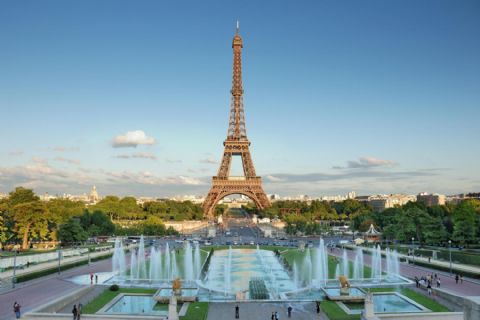KUPASONLINE.COM — Paris is the most popular tourist destination in the world, with 30 million foreign visitors per year. What should you do and see while you’re in this romantic city?
Paris is said to be the most romantic city in the whole world, there are a number of landmarks with various attractions, famous institutions, and also popular parks, attracting people like a big magnet. Here are 10 places you must visit when traveling to Paris.
Eiffel Tower
An iron tower built on the Champ de Mars on the banks of the river Seine. This tower has indirectly become a global icon of this country, as well as being one of the famous structures in the world. Built in 1889, with a structure height of 325m and an antenna length of 24 meters, if compared to a conventional building, it is the same as an 81-floor building.
Designed by Gustaf Eiffe, a French engineer and architect and a specialist in metal structures. So do not be surprised if the tower as a whole is made of iron, weighing 7,300 tons.
The first and second levels are accessible by stairs and elevator. A ticket booth in the south tower sells tickets to the steps that start there. On the first platform the stairs continue up from the east tower and the third level summit is only accessible by lift.
From the first or second platform the stairs are open to everyone going up and down depending on whether they have purchased a lift ticket or a stair ticket.
The number of steps is 9 to the ticket counter on the ground, 328 to the first level, 340 to the second level and 18 to the lift platform on the second level. When exiting the elevator on the third level there are 15 steps up to the upper observation platform. The number of rungs written gradually on the side of the stairs to give an indication of the ascent. Most of the ascent provides a view directly beneath and around the tower although an additional short flight of stairs closed.
Arch de Triomphe
Or the Triumphal Arch that stands majestically on the Place de l’Étoile. This building was built by order of Napoleon Bonaparte with the aim of honoring the services of his great army. The largest gate in the world measuring 45 x 22 x 50 meters, is decorated with many reliefs and statues depicting the Napoleonic wars.
The full name of the Arch de Triomphe de l’Étoile was built in 1806 as a sign of Napoleon’s victory against Asutria in the Austreliz war. Inspired by the Arc of Titus in Italy, on every wall is an all-in-one list of French war victories.
One of the interesting things about this gate, under the arch there is a tomb of an unknown soldier from World War I, his body was placed here [there was Armistice Day (Armistice Day) in 1920, and above his grave was written: “Ici Repose Un Soldat Francais Mort Pour La Patrie 1914 – 1918” (Here lies a French soldier who died for his homeland 1914 – 1918). Above this tomb there is a lantern whose fire never goes out. This fire is in memory of the soldiers who died in World War I & II and they are not identified.
On the inside of this gate, you can also take the elevator to reach the top where there is a museum which contains various explanations about this gate from the start of its construction. To reach the roof, you can ‘wade’ 46 steps, and from there, you can see the area around clearly.
Place de la Concorde
A large square located halfway between the Tuileries Garden and the Champ Elysees. Place de la Concorde is the main and largest square in Paris. This square has a long history, from changing names to the ‘attractions’ held here.
Initially, this square was built by Jaques Gabriel in 1755 with an octagonal or octagonal shape. In the center of it, a statue of King Louise XV was erected in his honor when he ascended the throne, but later this statue was torn down during the French revolution in 1792, and replaced with a new statue named Liberte (victory), and the square changed its name to La Revolution.
This square then changed again to the Place de Greve or the grave square, because here was laid a Guillotine in 1793, in a matter of 2 years, this ax has beheaded more than 1300 human heads alive, alive, and one of them is the King Louis XVI on January 21, 1793.
After 1979, the ax was removed from the square, and the square was renamed Place de la Concorde from 1830, to the present day.
Louvre Museums
Musee du Louvre, the largest museum in the world, and has the most complete collection from around the world, this museum was once a palace and fortress. Palais du Louvre is a span built in the 12th century under Philip II. Then this building was developed again into a palace as it is now(*)







